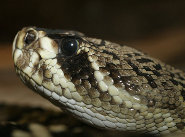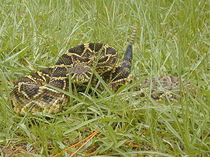Eastern diamondback rattlesnake
Eastern Diamondback - World’s Largest Rattlesnake
 The Eastern diamondback (Crotalus adamanteus) is the largest rattlesnake species in the world. It lives in the southeast coast of the United States, especially in sand dunes, edges of swamplands, coastal areas and woodlands. Although they avoid water, these snakes are strong swimmers. Although not considered an endangered species, rattlesnake numbers have been declining due to habitat loss, over-hunting and getting run over by traffic. Humans, large hawks and eagles are their only known predators.
The Eastern diamondback (Crotalus adamanteus) is the largest rattlesnake species in the world. It lives in the southeast coast of the United States, especially in sand dunes, edges of swamplands, coastal areas and woodlands. Although they avoid water, these snakes are strong swimmers. Although not considered an endangered species, rattlesnake numbers have been declining due to habitat loss, over-hunting and getting run over by traffic. Humans, large hawks and eagles are their only known predators.
The Eastern diamondback is poisonous. This venom is used to paralyze and partially digest their prey – rodents and rabbits. It is strong enough to kill an adult human. Rattlesnakes are not aggressive but will strike if they feel threatened. The Eastern diamondback will always rattle its tail in warning before biting.
General Appearance
The eastern diamondback rattlesnake is a large, thick-set snake with a bulbous head and a small, blunt nose. Eastern diamondbacks come in several coloration shades, but all sport a pale belly and a series of diamond-shaped black markings from the head to the beginning of the dry rattle-like tail. Colors can be a combination of tan, brown, olive-brown, yellow, rust-red and black. Each scale appears like a bead. The eyes are striped with black and white bands. Their dark eyes have pupil’s that resemble cat’s pupils.
Males grow larger than females. An adult male can weigh 10 pounds (4.54 kilograms). The longest male eastern diamondback ever captured measured 96 inches (244 centimeters) in length, but most adult males do not grow longer than 72 inches (183 centimeters) long. Females average a length of 33 inches (84 cm).
Life Habits
Unlike many other species of snakes, Eastern diamondbacks give birth instead of laying eggs. A fertile female can give birth to a littler of 12 - 24 baby snakes in July and August. Females can only mate every 2 or 3 years. The Eastern diamondback has two mating seasons in the spring and autumn. Males fight to win females in a territory by wrestling with each other. The parents take no care of their offspring. With luck, rattlesnakes can live to be 25 years old.
In late autumn, snakes head below ground to hibernate. They sometimes hibernate together in large colonies in order to keep warm. When not hibernating, rattlesnakes use a series of burrows or tree stumps to hide in. Their patchy coloration makes them blend in with the forest or sandy flooring. They hide and wait for prey to appear and suddenly strike.
Picture of the eastern diamondback by Tad Arensmeier from St. Louis, MO, USA, licensed under the Creative Commons Attribution 2.0 Generic license.
The Eastern diamondback rattlesnake is classified as Least Concern. Does not qualify for a more at risk category. Widespread and abundant taxa are included in this category.
Common names
Aruba Island rattlesnake in English - English
cascabel in English - English
Chřestýš kostkovaný in Czech - česky
Crotale diamantin in French - français
Crotalus adamanteus in Italian - Italiano
Diamant-Klapperschlange in German - Deutsch
Diamantratelslang in Dutch - Nederlands
Eastern Diamond-backed Rattlesnake in English - English
eastern diamondback rattlesnake in English - English
Grzechotnik diamentowy in Polish - polski
Rombinė barškuolė in Lithuanian - lietuvių kalba
tropical rattlesnake in English - English
مار زنگی پشت الماسی شرقی in Persian - فارسی

